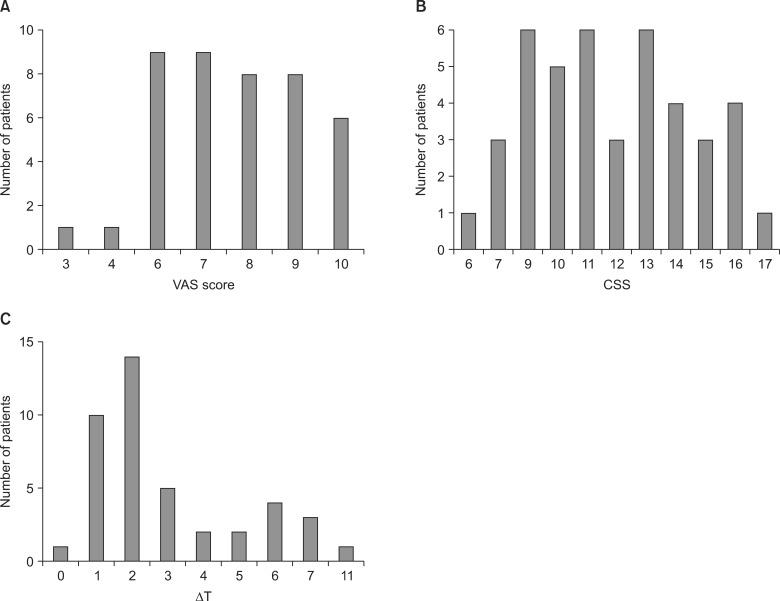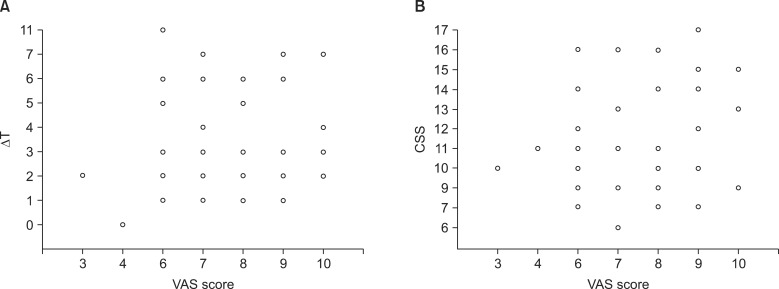Korean J Pain.
2014 Oct;27(4):339-344. 10.3344/kjp.2014.27.4.339.
Do Severity Score and Skin Temperature Asymmetry Correlate with the Subjective Pain Score in the Patients with Complex Regional Pain Syndrome?
- Affiliations
-
- 1Department of Anesthesiology and Pain Medicine, KEPCO Medical Center, Seoul, Korea.
- 2Kirin Pain Clinic, Seoul, Korea.
- 3Department of Anesthesiology and Pain Medicine, Seoul National University Bundang Hospital, Seongnam, Korea. hiitsme@snubh.org
- 4Department of Anesthesiology and Pain Medicine, Seoul National University Hospital, Seoul, Korea.
- KMID: 1802500
- DOI: http://doi.org/10.3344/kjp.2014.27.4.339
Abstract
- BACKGROUND
The diagnostic criteria of complex regional pain syndrome (CRPS) have mainly focused on dichotomous (yes/no) categorization, which makes it difficult to compare the inter-patient's condition and to evaluate the intra-patient's subtle severity over the course of time. To overcome this limitation, many efforts have been made to create laboratory methods or scoring systems to reflect the severity of CRPS; measurement of the skin temperature asymmetry is one of the former, and the CRPS severity score (CSS) is one of the latter. However, there has been no study on the correlations among the CSS, temperature asymmetry and subjective pain score. The purpose of this study was to evaluate whether there is any correlation between the CSS, skin temperature asymmetry and subjective pain score.
METHODS
Patients affected with CRPS in a unilateral limb were included in this study. After making a diagnosis of CRPS according to the Budapest criteria, the CSS and skin temperature difference between the affected and unaffected limb (DeltaT) was measured in each patient. Finally, we conducted a correlation analysis among the CSS, DeltaT and visual analogue scale (VAS) score of the patients.
RESULTS
A total of 42 patients were included in this study. There was no significant correlation between the DeltaT and VAS score (Spearman's rho = 0.066, P = 0.677). Also, the CSS and VAS score showed no significant correlation (Spearman's rho = 0.163, P = 0.303).
CONCLUSIONS
The DeltaT and CSS do not seem to reflect the degree of subjective pain in CRPS patients.
Keyword
Figure
Cited by 1 articles
-
Multicenter survey of symptoms, work life, economic status, and quality of life of complex regional pain syndrome patients
Jaemoon Lee, Yun Hee Lim, Sung Jun Hong, Jae Hun Jeong, Hey Ran Choi, Sun Kyung Park, Jung Eun Kim, Eun Hi Park, Jae Hun Kim
Korean J Pain. 2021;34(3):288-303. doi: 10.3344/kjp.2021.34.3.288.
Reference
-
1. Shin HY, Choi YM, Nahm FS, Park SJ, Koo MS, Suh JH, et al. Comparison of the two impairment classes publicized by the American Medical Association in complex regional pain syndrome patients. Korean J Pain. 2007; 20:148–153.
Article2. Harden RN, Bruehl S, Stanton-Hicks M, Wilson PR. Proposed new diagnostic criteria for complex regional pain syndrome. Pain Med. 2007; 8:326–331. PMID: 17610454.
Article3. Harden RN, Bruehl SP. Diagnosis of complex regional pain syndrome: signs, symptoms, and new empirically derived diagnostic criteria. Clin J Pain. 2006; 22:415–419. PMID: 16772794.4. Harden RN. Objectification of the diagnostic criteria for CRPS. Pain Med. 2010; 11:1212–1215. PMID: 20704669.
Article5. Stanton-Hicks M, Jänig W, Hassenbusch S, Haddox JD, Boas R, Wilson P. Reflex sympathetic dystrophy: changing concepts and taxonomy. Pain. 1995; 63:127–133. PMID: 8577483.
Article6. Bruehl S, Harden RN, Galer BS, Saltz S, Backonja M, Stanton-Hicks M. Complex regional pain syndrome: are there distinct subtypes and sequential stages of the syndrome? Pain. 2002; 95:119–124. PMID: 11790474.
Article7. de Mos M, de Bruijn AG, Huygen FJ, Dieleman JP, Stricker BH, Sturkenboom MC. The incidence of complex regional pain syndrome: a population-based study. Pain. 2007; 129:12–20. PMID: 17084977.
Article8. Harden RN, Bruehl S, Perez RS, Birklein F, Marinus J, Maihofner C, et al. Development of a severity score for CRPS. Pain. 2010; 151:870–876. PMID: 20965657.
Article9. Bruehl S, Lubenow TR, Nath H, Ivankovich O. Validation of thermography in the diagnosis of reflex sympathetic dystrophy. Clin J Pain. 1996; 12:316–325. PMID: 8969877.
Article10. Krumova EK, Frettlöh J, Klauenberg S, Richter H, Wasner G, Maier C. Long-term skin temperature measurements - a practical diagnostic tool in complex regional pain syndrome. Pain. 2008; 140:8–22. PMID: 18723287.
Article11. Choi E, Lee PB, Nahm FS. Interexaminer reliability of infrared thermography for the diagnosis of complex regional pain syndrome. Skin Res Technol. 2013; 19:189–193. PMID: 23331254.
Article12. Pleger B, Tegenthoff M, Ragert P, Förster AF, Dinse HR, Schwenkreis P, et al. Sensorimotor retuning [corrected] in complex regional pain syndrome parallels pain reduction. Ann Neurol. 2005; 57:425–429. PMID: 15732114.
Article13. Kemler MA, Barendse GA, van Kleef M, Egbrink MG. Pain relief in complex regional pain syndrome due to spinal cord stimulation does not depend on vasodilation. Anesthesiology. 2000; 92:1653–1660. PMID: 10839916.
Article14. Ciccone DS, Bandilla EB, Wu W. Psychological dysfunction in patients with reflex sympathetic dystrophy. Pain. 1997; 71:323–333. PMID: 9231876.
Article15. Geertzen JH, de Bruijn-Kofman AT, de Bruijn HP, van de Wiel HB, Dijkstra PU. Stressful life events and psychological dysfunction in Complex Regional Pain Syndrome type I. Clin J Pain. 1998; 14:143–147. PMID: 9647456.
Article16. Niehof SP, Huygen FJ, van der Weerd RW, Westra M, Zijlstra FJ. Thermography imaging during static and controlled thermoregulation in complex regional pain syndrome type 1: diagnostic value and involvement of the central sympathetic system. Biomed Eng Online. 2006; 5:30. PMID: 16689997.
Article17. Birklein F, Riedl B, Claus D, Neundörfer B. Pattern of autonomic dysfunction in time course of complex regional pain syndrome. Clin Auton Res. 1998; 8:79–85. PMID: 9613797.
Article18. Veldman PH, Reynen HM, Arntz IE, Goris RJ. Signs and symptoms of reflex sympathetic dystrophy: prospective study of 829 patients. Lancet. 1993; 342:1012–1016. PMID: 8105263.
Article19. Park EJ, Han KR, Chae YJ, Jeong WH, Kim C. Effectiveness of cold stress thermography in the diagnosis of complex regional pain syndrome type 1. Korean J Pain. 2006; 19:159–163.
Article20. Gulevich SJ, Conwell TD, Lane J, Lockwood B, Schwettmann RS, Rosenberg N, et al. Stress infrared telethermography is useful in the diagnosis of complex regional pain syndrome, type I (formerly reflex sympathetic dystrophy). Clin J Pain. 1997; 13:50–59. PMID: 9084952.
Article21. Nahm FS, Lee PB, Park SY, Kim YC, Lee SC. Comparison of the diagnostic validity of real and absolute skin temperature differences for complex regional pain syndrome. Korean J Pain. 2009; 22:146–150.
Article
- Full Text Links
- Actions
-
Cited
- CITED
-
- Close
- Share
- Similar articles
-
- Comparison of the Diagnostic Validity of Real and Absolute Skin Temperature Differences for Complex Regional Pain Syndrome
- Effectiveness of Cold Stress Thermography in the Diagnosis of Complex Regional Pain Syndrome Type 1
- A Case of Intractable Chest Pain of Unknown Origin which was Suspicious of Complex Regional Pain Syndrome Type I: A case report
- Diagnosis and Treatment of Complex Regional Pain Syndrome
- Complex Regional Pain Syndrome: Mechanism, Diagnosis and Treatment



